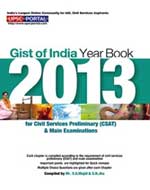(HOT) UPSC Current Affairs 2025 PDF
NEW! The Gist (NOV-2025) | E-BOOKS
(Sample Materials) Gist of India Year Book 2013 - "Finance"
Contents of the Chapter:
- Intoduction
- Asian Development Bank
- Economic Affairs
- MGNREGS
- Thirteen Finance Commission
- Financial Action Task Force
- Financial Stability and Development
- Banking
- RBI
- Bilateral Relation
- International Monetary Funds
- Insurance
- World Bank
- Evaluate Yourself
Introduction
- The Ministry of Finance comprises four departments, namely, (i) Economic Affairs, (ii) Expenditure, (iii) Revenue, and (iv) Disinvestment.
ECONOMIC AFFAIRS
-
There are 9 divisions of the Department of Economic Affairs (DEA), which are as follows : (i) Finance Division, (ii) Budget Division including Fiscal Responsibility and Budget Management (FRBM), (iii) Capital Market, (iv) Bilateral Co-operation and Administration, (v) Multilateral Institutions, (vi) Multilateral Relations, and Administration, (vii) Controller of Aid, Accounts and Audit, (viii) Economic Division and (ix) Directorate of Currency.
- The DEA is also responsible for preparation and presentation to the Parliament of Central Budget and the Budgets for the State Governments under President’s Rule and Union Territory Administrations.
Annual Budget
Annual Financial Statement
-
Under Article 112 of the Constitution, a statement of estimated receipts and expenditure of the Government of India has to be laid before Parliament in respect of every financial year which runs from 1st April to 31st March. This statement titled “Annual Financial Statement” is the main Budget document. The Annual Financial Statement shows the receipts and payments of Government under the three parts in which Government accounts are kept; (i) Consolidated Fund, (ii) Contingency Fund and (iii) Public Account.
Finance Bill
-
At the time of presentation of the Annual Financial Statement before Parliament, a Finance Bill is also presented in fulfilment of the requirement of Article 110 (1) (a) of the Constitution, detailing the imposition, abolition, remission, alteration or regulation of taxes proposed in the Budget. A Finance Bill is a Money Bill as defined in Article 110 of the Constitution.
Vote-on-Account
-
The whole process beginning with the presentation of the Budget and ending with discussions and voting on the Demands for Grants requires sufficiently long tim.e The Lok Sabha is, therefore, empowered by the Constitution to make any grant in advance in respect of the estimated expenditure for a part of the financial year pending completion of procedure for the voting of the Demands. The Purpose of the ‘Vote on Account’ is to keep Government functioning, pending voting of ‘final supply’. The Vote on Account is obtained from Parliament through an Appropriation (Vote on Account) Bill.
Sources of Revenue
The main sources of Union tax revenue are Customs duties, Union excise duties, Service tax, Corporate and income taxes. Non-tax revenues largely comprise interest receipts, loan repayments, dividends and profits.
Transfer of Resources
-
In the revised estimates (RE) of 2011-12, the devolution of tax receipt from the union government to the states as their share of taxes and duties was Rs. 255414 crore. In BE (Budget Estimates) 2012-13, this amount has been increased from Rs. 189619 crore in RE 2011-12 to Rs. 222887 crore in BE 2012-13. In addition to above, resources are also transferred by Union Government directly to the state level implementing agencies under various schemes and programmes through budgetary support.
Public Debt
- The total net liabilities of the Government of India in BE 2011-12, is estimated at 43,52,389 crore as against Revised Estimates (RE) 39,30,805 crore at the end of 2010-2011.
New Initiatives in Fiscal Management
-
To check the potentially damaging impact the lack of fiscal discipline on macro-economic parameters, the Parliament had passed the Fiscal Responsibility and Budget Management (FRBM) Act, 2003 which came into force in July 2004, The FRBM Act, inter alia, mandates the Government to eliminate the revenue deficit by 2008-09. As per the FRBM Rules, a minimum annual reduction in the revenue deficit of 0.5 per cent of GDP is targeted. The process of fiscal consolidation during the FRBM Act regime has created necessary fiscal space to undertake much needed social sector expenditure and provide for higher infrastructure outlays.
The Budget for 2012-13 estimates the fiscal deficit for 2012-13 at 5.1 per cent of GDP. The Medium Term Fiscal Policy Statement 2012-13 has provided the roadmap for renewed fiscal consolidation with fiscal deficit declining to 4.5 per cent of GDP in 2013-14 and further to 3.9 per cent of GEP in 2101- -15 The deficit targets envisaged in the Budget 2013-13 are as follows:
1. Consider the following statements:
- All revenues received by the government, loans raised by it and all granted, from consolidated fund of India.
- Contingency fund incurs such expenditures which are urgent and unforeseen.
Which of the above statements is / are correct?
- 1 only
- 2 only
- Both 1 & 2
- Neither 1 nor 2
2. Consider the following statements about CST:
- CST is origin based tax.
- VAT is a destination based tax.
- CST is levied under the provisions of Central Sales Tax Act, 1956.
Which of the above statements is / are correct?
- 1 & 2 only
- 1 & 3 only
- 2 & 3 only
- All of the above


